
| January 2002 | ||||||
| Sun | Mon | Tue | Wed | Thu | Fri | Sat |
| 1 | 2 | 3 | 4 | 5 | ||
| 6 | 7 | 8 | 9 | 10 | 11 | 12 |
| 13 | 14 | 15 | 16 | 17 | 18 | 19 |
| 20 | 21 | 22 | 23 | 24 | 25 | 26 |
| 27 | 28 | 29 | 30 | 31 | ||
Tuesday 29 January 2002
At 1200, EST the Training Ship Empire State was located 30 nautical miles east northeast of Vera Cruz, Mexico, at 19 degrees and 38 minutes North Latitude and 095 degrees 51 minutes West Longitude, steering course 050 degrees true at a speed of 11 knots. The weather was excellent; clear, wind from the east southeast at 15 knots, air temperature was 80 degrees Fahrenheit, barometric pressure was 1017 millibars, seas were from the southeast at 1 to 3 feet, sea injection temperature was 78 degrees Fahrenheit. Depth of water beneath the keel was 1270 meters.
CAPTAIN'S LOG
"I have found out that there ain't no surer way to find out whether you like people or hate them than to travel with them." Mark Twain: (1835-1910)
Well, we're findin' out whether Mark Twain was right cause we're travelin'. Nothing quite as romantic as bucking the Mississippi aboard some smoke belching paddle wheeler or doodling with bare toes in the powdery dust of Hannibal, Missouri but stimulating one's senses with the distinctive pleasures of Vera Cruz, Mexico and sailing the breathtakingly beautiful waters of the Gulf ain't too bad. We'll take it 'til something better comes along.
Mark Twain knew about traveling and the everyday adjustments that are part of it, now many of our inexperienced cadets do, as well. The first liberty port generally creates and destroys a plethora of hateful emotions as selfish habits cultivated in the private suite environs of home clash headlong with shipboard realities and 156 roommates. Just imagine; sociable, fun loving cadets back from a tranquil night on the town. They tip toe quietly into the communal berthing space and find to their utter surprise, the entire four to eight watch section hurrying from their warm bunks to cheerfully greet them. Wrong! What they actually find is the neurotic, ship bound duty section from hell, breathing fire and brimstone and speaking in tongues. Rudeness does that; and when added with small measures of sleep deprivation, and unrequited want to be ashore, one has a critical mass. The first port exposes everyone equally, to the problems associated with conducting 24 by 7 operations among people with divergent and often competing interests. Out of the conflict comes real concern for the needs of others and understanding of shipboard etiquette. Things will be different in the next port and not one staff member will have been involved in writing the lesson plan.
Liberty ended just as predicted; nearly everyone arrived home on time but with a few stragglers. Those who suffered time - distance impediments are in deep reflection today, and wondering if the time they get will be worth the time they got. Mercifully, the wait to judgment is short. Such is the shocking reality of experiential education.
The first underway watch section began preparations for getting underway last evening, precisely as scheduled. They made quick work of numerous pre sail checklists as the complex systems were readied for sea. The following watch standers fine-tuned and calibrated crucial components, by dawn, the spinning radars were stirring the light blue smoke issuing from the stack, and all was ready. Again, the performance of the Cadets and the metamorphic changes in them are amazing. We've been at sea only slightly more than two weeks yet most perform as if they sailed with Francis Drake. They take great pride in staying ahead of the staff and my legs grow weary trying to keep up. I wouldn't have it any other way. I was slightly behind when at 0756 this morning, the Cadet Officer of the Deck welcomed the Harbor Pilot to the bridge, exchanged pleasantries and set to work. A scant twenty minutes later, the very professional deck crew hauled the last line to the rail, and Empire State backed smoothly into the stream.
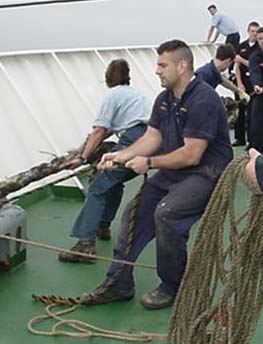
The thick hawsers were expertly stowed while we cautiously maneuvered the narrow channel eastward toward the open sea.
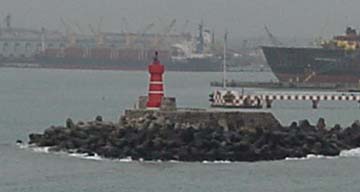
We thanked the Pilot and at 0900, 586 shore weary sailors waved good-bye to Vera Cruz; the Officer of the Deck came left to 050 degrees true, ordered ahead standard, and we were off to Georgetown, Grand Cayman. For those who might be interested, we sailed with 9,250 barrels of fuel oil and 832 long tons of fresh water. That should hold us until the first rest stop.
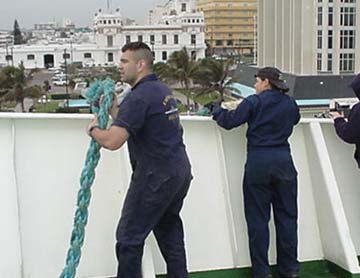
Adios, Amigos....Hasta Luego
CADET'S COMMENT
Tour of Vera Cruz, Mexico
By 1/c Katelyn Ladden
Finally, I have time to sit down, relax and tell my stories from Mexico. All day Saturday I was on watch: from 0800 Saturday until 0800 Sunday. Luckily, I was able to get some rest throughout the day by switching duty responsibilities with 1/c Adam VanEtten. The new watch that I was standing was instituted for added security especially at the end of liberty hours. So, on Sunday morning, I left the ship for the first time. I signed up for a tour of Nanciyaga and Catemaco and we met our tour guides at a hotel near the ship. We packed two vans with people and set out for the tour that turned out to be the scariest "roller coaster ride" of my life. To say the least, The driving is very different in Mexico. I felt like I was on a racetrack, trying to pass and beat every other car on the road. Our driver would speed-up, crowd the bumper of the car ahead, and then swerve into the other lane to pass. We were in the left hand lane for most of our trip! To add special effects to the ride, random speed bumps are stategically placed all over Vera Cruz. Cars fly down the road, then come to a screeching halt to slowly roll over the speed bumps. Whiplash anyone? Needless to say, the driver had to refill all the tires TWICE on the trip. Driving through Vera Cruz was a tour in itself... although not a listed attraction on the guide I read! Our first destination was the town of San Andres and a visit to a tobacco factory. Unfortunately, it was Sunday and nobody was actually rolling cigars, but a Mexican worker demonstrated the cigar making process. Vera Cruz is famous for their tobacco products and we saw boxes ready for shipment to all parts of the world- including Canada, Australia, and Russia.
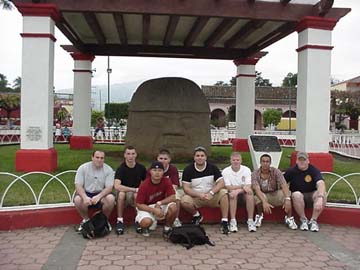
Our next stop was in Santiago at an archaeological museum and to visit the famous Eyipantla Waterfall. Enroute to our different destinations, our tour guide, Maurice, continued a running narrative of the history of Vera Cruz. An archaeologist by training, Maurice does guide work to supplement his meager income. When we arrived at the museum, the talented Maurice also acted as our tour guide. We saw figures, statues, utensils, pottery, and weapons that were used by the people who once lived in the area and the town square contained one of the most famous carved stone heads.
Next we went to the Waterfall.
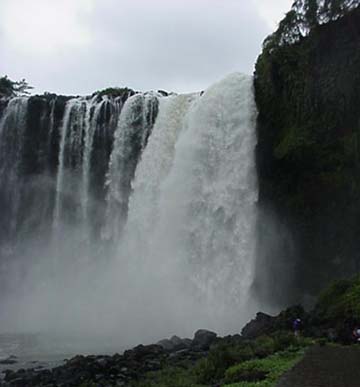
Since it is a well known tourist attraction, there are many shops and people selling all kinds of food and trinkets. Children are also an active part of the sales force and approach tourists for money, to make a sale, or to hold hands. I did not notice the steep angle of descent while going to the waterfall, but as we climbed up the steps, I suddenly became aware of the difficulty of the climb. There are 305 steps down to the waterfall and twice that many coming back! We got as close as we could to the waterfall without getting completely soaked but the mist was refreshing on the hot and sunny afternoon.
The last part of our tour took place by boat. We headed to Catemaco to see the Ecological Reserve of Nanciyaga and Monkey Island. Nanciyaga is the most northerly path of tropical rain forest on the planet and it is also where the movie, the "Medicine Man" was filmed. It was paradise to the most ancient mesoamerican civilization. The Olmecs, who once inhabited this area, brought knowledge honoring the Jade, which still can be found in the landscape today. Paul, our tour guide, escorted us around the reserve. We saw many figures and statues representing the Olmec people and their culture. We went to the Cemelli, which means house of beauty where some of the tour group had natural mud masks applied to their faces.
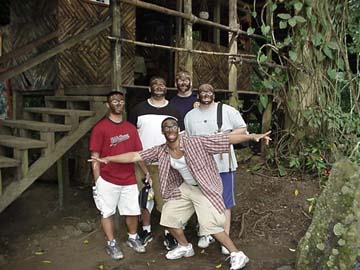
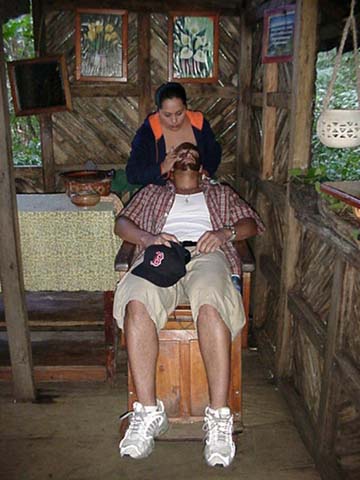
Next, we saw plants and trees that are used as cures for insect bites and diseases like Diabetes. We also viewed artificial trees which were built as props for filming of "Medicine Man" and we used leaves to make cups to drink water directly from the cool, refreshing mineral springs.
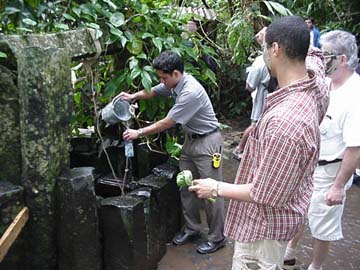
Afterwards, we filled our on bottles for the long trip home. Next, we visited the Shaman, or medicine man. He is considered one of the best healers in the region. He lives in a hut and when visitors enter he waves leaves all around and he speaks. 3/c Solomon Haddad actually went inside. He could not understand what the Shaman was saying because he spoke in Spanish. When he emerged he was wearing a necklace with a replica of an Olmec statue. The Shaman instructed him to either wear it or to keep it near his bed and never give it to anyone else. The last attraction at the reserve was the animal breeding enclosures. The people on the island help reproduce and preserve the indigenous species including wild African geese, turtles, crocodiles, and toucans. The ecological preserve was my favorite part of the tour. Then we boarded the boat and headed to Monkey Island.
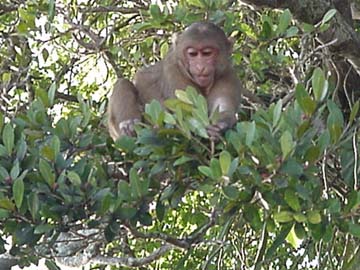
We did not get out of our boat because the island is protected but we motored through the trees and tossed peanuts and bananas to the monkeys. We also placed food on the bow to entice the monkeys aboard and we were almost attacked by monkeys trying to get at our food.
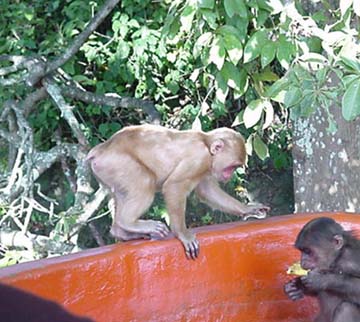
We ended the wonderful day with dinner at an authentic Mexican restaurant. We were starving after the eleven hour tour and tired. Most of us fell asleep on the ride home. Everyone enjoyed learning about the history and culture of Vera Cruz.
QUESTIONS FOR WEDNESDAY 30 JANUARY
MATH: Cadet Walsh went into Vera Cruz with $480.70. She shopped for special gifts to take back to her family in Maryland. She drew checks for $23.80, $65.00, and $165.00 dollars to pay for her purchases. She received a birthday gift of $200.00, which she deposited in the checking account. What was her new balance?
SCIENCE: Water Vapor that condenses and forms clouds can fall to the earth as precipitation. What forms can this precipitation take?
GEOGRAPHY: What small ocean creature is harvested by the millions from the Gulf of Mexico? The season usually starts around the beginning of July and most of the work is done at night.
HISTORY: One of the states of the United States that has a long coastline along the Gulf of Mexico is Texas. Texas was once an independent COUNTRY. What was the name of that COUNTRY?
ANSWERS FOR TUESDAY 29 JANUARY
MATH: Compare the number of tails, 8, to the total number of tosses, 20. 8/20 = 0.40 or 40%
SCIENCE: Anthropology
GEOGRAPHY: Other countries that grow this product are: Canada, China, Cuba, Brazil (leads in exporting this product), Greece, India, Norway, Turkey, Zimbabwe, and Mexico.
HISTORY: Tobacco